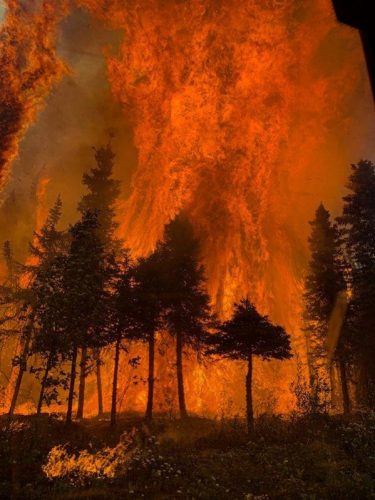Study forecasts a more fiery future for Southcentral Alaska
May 10, 2021
Tom Moran
907-474-5581

Some of the weather conditions that led to the destructive McKinley and Swan Lake fires in 2019 could be a mainstay of Southcentral Alaska summers in the future, according to a recent article by a team of scientists with the Established Program to Stimulate Competitive Research.
Twenty-three researchers — 13 of them core members of the EPSCoR Boreal Fires team — collaborated on an article recently published in the journal Land. The team included 14 scientists from the University of Alaska Fairbanks and two from the University of Alaska Anchorage.
The researchers studied Southcentral Alaska’s unusual 2019 fire year for signs of human influence on the climatological factors that precipitated the fires. After extrapolating their results through the coming decades, they found that Southcentral summers are expected to get both hotter and wetter. However, that temperature growth will be more pronounced than higher moisture, increasing fire risk.
“The heat is overtaking the moisture,” explained lead author Uma Bhatt, UAF professor of atmospheric science. “Precipitation is going up, but temperature is really going up. The warming is winning out.”
The summer of 2019 was unusual in Southcentral Alaska. Whereas seasonal rains generally quash the fire season by late July, persistent hot and dry weather and high-wind events led to a spate of late-season conflagrations, such as the McKinley Fire north of Willow and a resurgent Swan Lake Fire on the Kenai Peninsula. The ongoing fires led to prolonged periods of poor air quality and cost $70 million to suppress.
“Some of the fires, in Swan Lake, for example, they had started in June and had been smoldering,” said Bhatt. “Typically those go out once it starts raining, but it was dry and a few things happened and they just erupted.”
Researchers wanted to study whether impacts of human-driven climate change — “the anthropogenic signal” — can be detected in these fires, as it already has been in Interior Alaska. They studied temperature and precipitation data from both the Susitna Valley and the Kenai Peninsula, and climate model simulations from the National Center for Atmospheric Research.
The scientists quantified fire risk using the Standardized Precipitation Evapotranspiration Index (SPEI), a measure of surface wetness or dryness, and thus flammability.
The team found that 2019 was indeed an extraordinary fire year — it had both the hottest and driest June-August period in Southcentral Alaska in the last 40 years. However, the researchers determined that despite that year’s extreme conditions, the anthropogenic signal has thus far been minimal in Southcentral Alaska. The likelihood of any month’s average SPEI in 1979-2019 being higher than that month’s extreme SPEI in the preindustrial era is still quite small — only about 2%, depending on the month.
However, they also calculated values for the years 2040 to 2080. They found a much more pronounced likelihood that average SPEI in any month will rise beyond preindustrial extremes: about 13% in June, 9% in July and 7% in August.
These numbers are considerably smaller than those researchers have estimated for the hotter and drier Interior Alaska. An earlier study estimated that the anthropogenic signal has increased the risk of an event like the 2015 Interior Alaska fire season by 34%–64%. But Bhatt said the Southcentral numbers still indicate a southward progression of human impacts on Alaska’s fire season.
“On the North Slope, we’ve been saying for a long time how human impact, anthropogenic climate change has been visible, and then the 2015 paper showed it was in the Interior,” Bhatt noted. “And now we’re finally getting hints of it farther south.”


